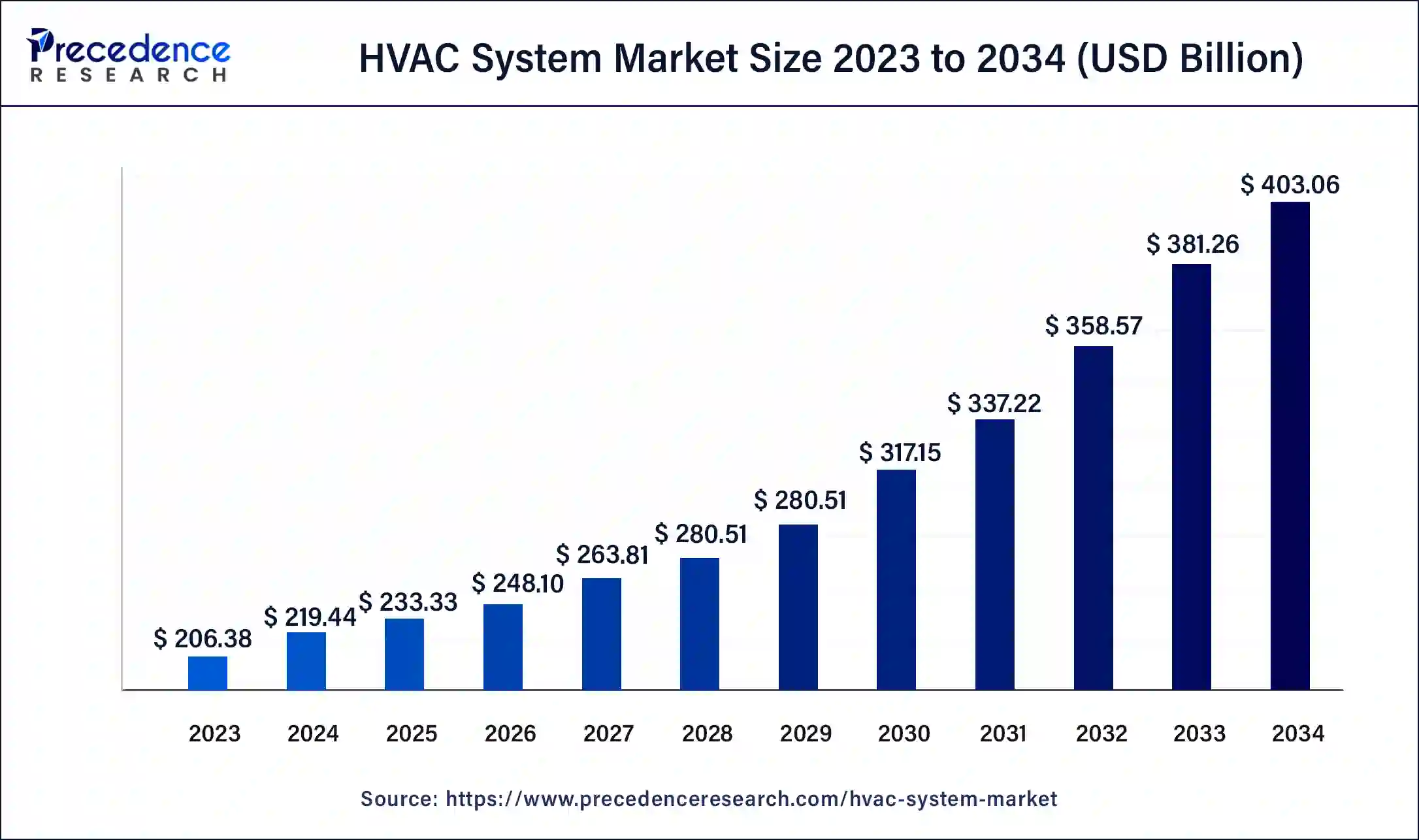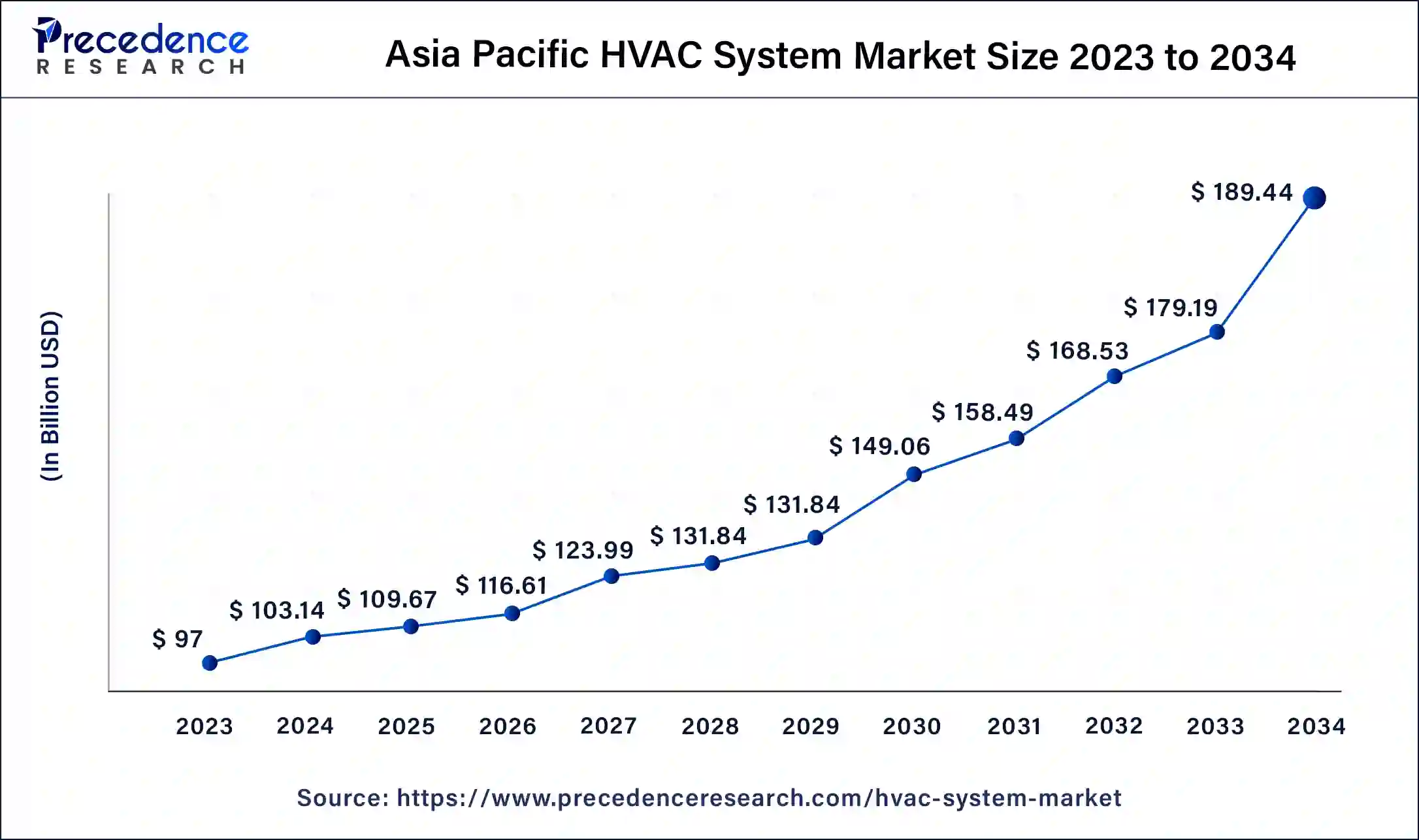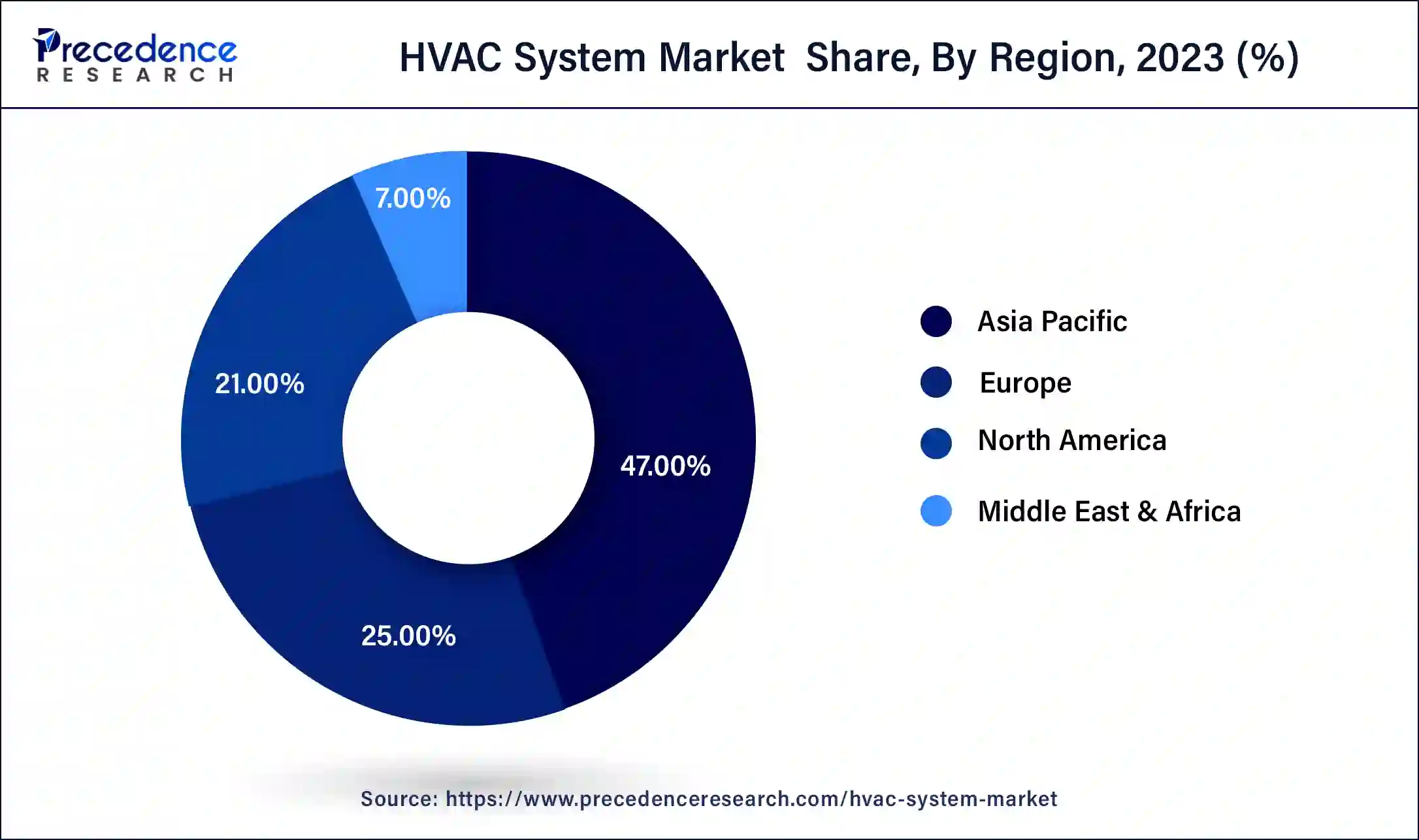January 2025
The global HVAC system market size was USD 206.38 billion in 2023, estimated at USD 219.44 billion in 2024 and is anticipated to reach around USD 403.06 billion by 2034, expanding at a CAGR of 6.3% from 2024 to 2034.
The global HVAC system market size accounted for USD 219.44 billion in 2023 and is anticipated to reach around USD 403.06 billion by 2034, growing at a CAGR of 6.30% from 2024 to 2034. The rising construction activities, especially in developing countries, are driving the expansion of the market.

The Asia Pacific HVAC system market size was estimated at USD 97 billion in 2023 and is expected to be worth around USD 189.44 billion by 2034, growing at a CAGR of 7% from 2024 to 2034.

Asia Pacific led the HVAC system market with the largest market size in 2023. The growth of the market is owing to the continuously rising population and developing economic growth of the regional countries that are driving the expansion in industrialization and construction activities. The rising construction activities such as development of the residential, commercial, and industrial building that accelerate the demand for the HVAC system as the cooling and maintaining indoor temperature with the good air quality. The increasing investment in technologies and the innovation in luxury and consumer electronics fir enhancing lifestyle standards are further propelling the growth of the HVAC system market in the region.

North America is expected to witness the fastest growth in the market during the forecast period. The growth of the market is attributed to the well-established economies in the region and the increasing investment in technologies that make life easy and convenient for the population. The rising intervention of the major players for the further development of the HVAC system with the integration of IoT in the system enhanced the popularity of the system and accelerated the demand for the HVAC system market in the region
The HVAC system market offers solutions and services that are utilized in battling against the increased environmental temperature, humidity, and bad air quality due to constant rise in pollution. HVAC stands for heating, ventilation, and air conditioning system. HVAC helps in maintaining the indoor temperature control, humidity, and improved the air quality. The HVAC system comes in two different variants that are hybrid, and split systems. Air conditioners, heat pumps, furnaces, thermostat, air ducts and vents, and air handlers are some of the main components of the HVAC system. The rise in the construction activities and the increasing demand for the HVAC system in the commercial, residential, and industrial buildings for maintaining the temperature and air quality that driving the growth of the HVAC system market.
| Report Coverage | Details |
| Growth Rate from 2024 to 2034 | CAGR of 6.30% |
| Global Market Size in 2023 | USD 206.38 Billion |
| Global Market Size in 2024 | USD 219.44 Billion |
| Global Market Size by 2034 | USD 403.06 Billion |
| Largest Market | Asia Pacific |
| Base Year | 2023 |
| Forecast Period | 2024 to 2033 |
| Segments Covered | By Cooling Equipment, By Heating Equipment, By Ventilation Type, By Implementation Type and By Application |
| Regions Covered | North America, Europe, Asia-Pacific, Latin America, and Middle East & Africa |
Rise in the construction industry
The growing construction industry is one of the major factors that drives the expansion of the HVAC system market. The globally rising population drives the demand for residential, commercial, and industrial properties that drives the requirement for the temperature controlling system which drives the growth of the market. The increasing investment on the development of commercial and public properties such as government offices, hospitals, malls, theme parks, sport centers, stadiums, conventional centers, etc. is driving the growth of the construction industry. The HVAC system is highly installed in malls, office spaces, and other commercial, and industrial buildings for maintaining the temperature and humidity at a comforting level. Additionally, the increasing trends towards the building renovations are further propelling the demand of affordable and efficient temperature maintaining systems that drive the growth of the HVAC system market.
Cost of the system
The higher cost of the HVAC system is limiting the expansion of the market. The cost of installation and maintenance of the HVAC system and the unawareness about the HVAC system in many developing countries are restraining the growth of the HVAC system market. Such a high cost of production as well as maintenance creates limitations in the adoption of such systems, especially where budget is a constraint. Thereby, the market is observed to get hampered by the cost factor.
Advancement in technology
The increasing investments in the development of technologies such as innovation and adoption of smart HVAC systems are observed to offer the opportunity for the market. The heavy installation of the smart HVAC system by the commercial, residential, and industrial building that can be remotely monitors, controlled, and managed by the single centralized system results in the higher demand for the smart HVAC system. Additionally, the integration of the IoT (Internet of Things) in the HVAC system that provides the real-time insights about the temperature, energy consumption, environmental issues, humidity, and other that helps in maintenance of the HVAC system and reduces the energy consumptions, time, and cost of the building properties.
The VRF system dominated the HVAC system market with the highest market share in 2023. The growth of the segment is attributed to the rising demand for VRF systems by the residential and commercial buildings due to its ability to cool the indoor temperature within greater efficiency. The VRF stands for the variable refrigerant flow typically relies only on refrigerant cooling instead of water-based cooling system. VRF is highly efficient and has the properties to save energy due to the use of the inverter compressor. The VRF system has the higher efficient in cooling and heating solutions in the commercial and residential properties with the high upfront cost for increase energy saving and HVAC customization.
The higher investment in the development of the VRF technologies with the smart technologies integration and cost saving alternatives and the rising demand from the residential and commercial buildings are boosting the demand for the VRF system in the market.
The heat pump is expected to experience a significant growth rate in the HVAC system market during the forecast period. Heat pumps are one of the important parts of the HVAC system that can be installed outside the buildings. It has the ability to provide heat in cooler months. The heat pumps are used to provide heat and cooler temperature as per the requirement and seasons which reduces the need for a separate system for the buildings. Heat pumps require much less electricity to work than other electric boilers, it does not require any fossils to work hence it is environmentally friendly. Thus, the properties like environmentally friendly, and cost effectiveness are driving the growth of the segment in the market.
The air filters segment is observed to witness a significant market growth rate during the anticipated period. Air filters are one of the major important components in the HVAC system due to it directly impacting the health of the human. Air filters in HVAC are observed to offer improved air quality as well as increased the life of the HVAC system. Air filter is due to trap the contaminants and pollutant substances of the air like mold spores, pollen, dust, and other type of bacteria’s and allergens and provide the safer and good quality of air in indoors. It protects the potential damage of the HVAC components from additional pollutants and increases the longevity of the system.
The quality of the air filter is directly impacting the durability of the HVAC system, though the good quality of the air filter allows the system to run more effectively. The heavy investment on the development in the air filter technologies are further propelling the growth of the market.
The new construction segment held the largest share of the HVAC system market in 2023. The rising investments in construction activities due to the rising demand for the residential and commercial properties for serving the increasing global population that contributing on the higher demand for the HVAC system. The increasing investment by the government bodies on the construction of the green building for reducing the carbon emission and decrease pollution level are also contributing to the expansion of the market. The HVAC system reduces the pollution level with the cost-efficient properties that are driving the growth of the market.
The residential segment HVAC system market in 2023. The rising construction of the residential building due to the rising population and urbanization that contributing to the rising demand for the HVAC system in the household properties for maintaining the indoor temperature cool and improves the air quality that drives the growth of the market. The rising investment in the real-estate industry and rising tendencies of buying residential properties in the economically developed countries are boosting the demand for the HVAC system market. Growing urbanization and the rising shift towards the hassle-free luxury lifestyle electronics in the home by the population are highly contributing to the growth of the market.
HVAC System Market Segments Cover Report
By Cooling Equipment
By Heating Equipment
By Ventilation Type
By Implementation Type
By Application
By Geography
For inquiries regarding discounts, bulk purchases, or customization requests, please contact us at sales@precedenceresearch.com
No cookie-cutter, only authentic analysis – take the 1st step to become a Precedence Research client
January 2025
September 2024
October 2024
July 2024